How the Houthis could retaliate against the US for airstrikes by shutting down a fifth of the world’s internet
Iran-backed Houthi militants in Yemen could try to sabotage internet cables in the Red Sea that carry nearly a fifth of the world’s internet traffic, according to a wave of new warnings.
The Yemeni government warned that the Red Sea is “one of the three most important cable meeting points” in the world and that the Houthis pose a “serious threat to one of the world’s most important digital infrastructures.”
It came after a Houthi social media channel published a map showing the routes of several cables through the Red Sea, the Gulf of Aden and the Arabian Sea.
The map was accompanied by the ominous message: “It appears that Yemen is in a strategic location, as internet lines connecting entire continents – and not just countries – pass close to it.”
There are warnings that Houthis could figure out a way to cut internet cables in the Red Sea, which carry 17 percent of the world’s internet traffic; Some cables lie just 100 meters below the surface, raising fears the Iran-backed group could target them
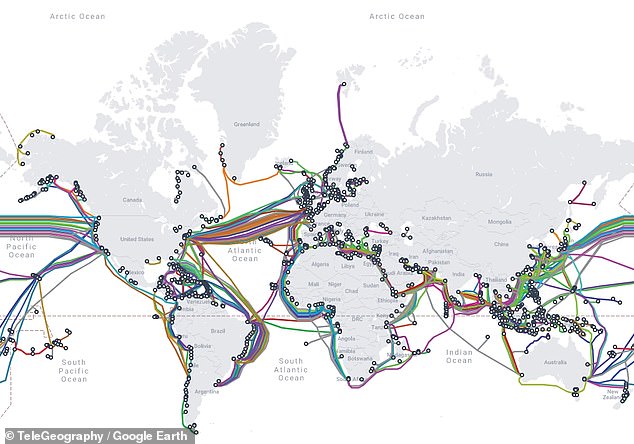
A map of underwater cables connecting the continents. There are growing fears that Houthi militants could disrupt the Red Sea transit

A Houthi participates in a rally in support of Palestinians in the Gaza Strip, and the recent Houthi attacks on shipping in the Red Sea and Gulf of Aden on February 4, 2024, on the outskirts of Sana’a, Yemen
The Houthis, who control parts of Yemen, began attacking international shipping in the Red Sea on November 19 in support of Hamas in its war with Israel in Gaza.
Since then, several dozen ships have caused major disruptions to global trade, with about 12 percent passing through the Red Sea.
The US and Britain have launched a massive airstrike campaign against them.
Now there are concerns that the Houthis could respond by targeting the internet and the transfer of financial data.
It is estimated that 17 percent of global internet traffic passes through underwater fiber optic cables in the Red Sea.
The average depth of the Red Sea is 450 meters, but some are at depths of only 100 meters.
Sixteen cables run through it, including a sprawling 15,000-mile cable called Asia Africa Europe-1 (AAE-1), which provides broadband to Asia and Europe.
It connects a litany of countries including France, Italy and Greece, Egypt, Saudi Arabia, China, Vietnam, Cambodia, Malaysia, India and Pakistan.
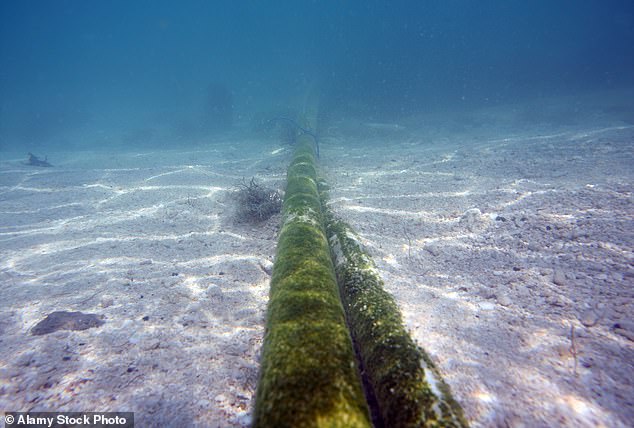
An undersea cable, some of which are not much wider than a snake and could be a target for Houthis
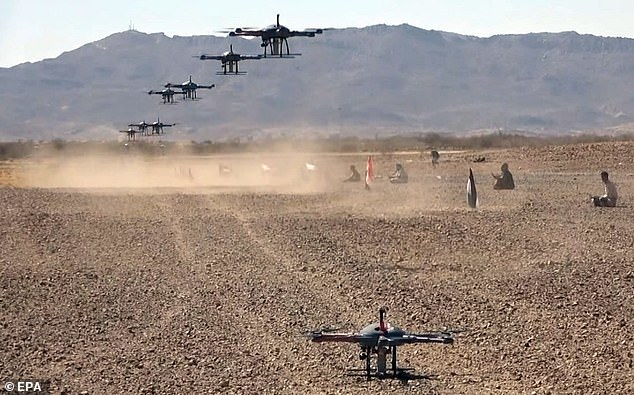
Houthis operate drones during a military exercise in a remote area on the outskirts of Sana’a, Yemen, February 3, 2024
Moammar al-Eryani, Yemen’s information minister, said the Houthis are now “posing serious threats to the global communications sector and economy.”
He added: “We are dealing with an unruly group, its terrorism has no ceiling or limits, and its crime exceeds all expectations.”
Yemen’s General Telecommunications Company said it had urged global internet providers in recent years not to do anything that would give the Houthis access to the cables or the way they operate.
In a statement on Monday, the Houthi denounced “threats to target international maritime cables.”
Emily Milliken, principal analyst at Askari Defense and Intelligence near Washington DC, wrote in the Gulf Security Forum that the Houthi group “could adapt its strategy to tackle a new – and perhaps more critical – target: the network of submarine telecommunications cables along the Bab al-Mandab strait.”
The Bab al-Mandab, which means ‘Gate of Tears’ in Arabic, connects to the southern Red Sea and the adjacent Gulf of Aden.
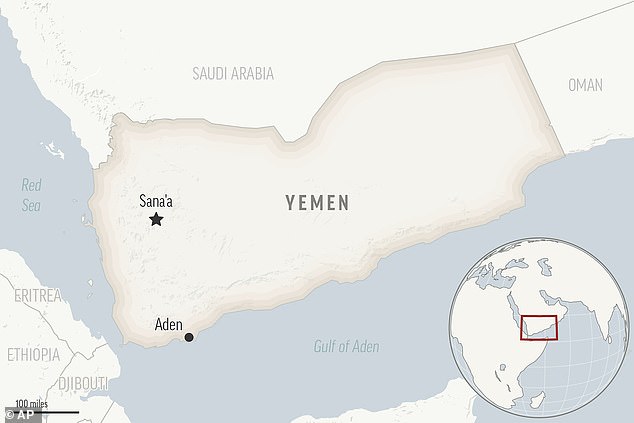
Underwater cables run through the Red Sea and Gulf of Aden, carrying 17 percent of the world’s internet traffic
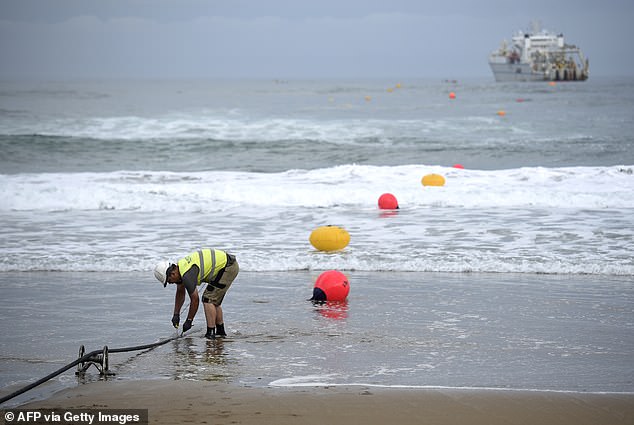
An operator works during the mooring of a submarine fiber optic cable on Arrietara beach near the Spanish-Basque village of Sopelana on June 13, 2017
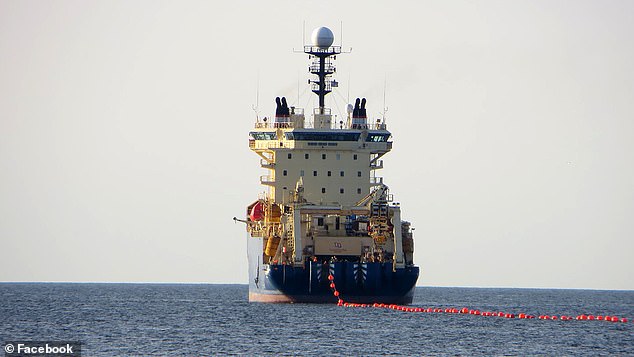
Facebook is developing a 23,000-mile undersea cable to bring high-speed internet to 16 underserved countries in Africa and the Middle East
“So far, the cables have been kept safe by the Houthis’ relative technological underdevelopment rather than a lack of motivation,” Milliken wrote. ‘They lack the submarines needed to reach the cables.
“However, given enough time and opportunity, the Houthis may be able to adapt some of their maritime tactics to attack vital communications infrastructure.”
The shallow waters “reduce the need for high-tech submarines to get the job done,” she wrote.
Even more troubling for Washington and its allies in the region, cutting the cables could “cut off military or government communications.”
There is precedent for attacks on underwater internet cables.
In 2013, the Egyptian coast guard caught three divers cutting a cable near the Mediterranean port city of Alexandria, causing major disruptions.
The Houthis have used a range of advanced weapons, including ballistic missiles and ‘kamikaze’ drones, in their attacks on international shipping in the Red Sea.
They are also known to have trained divers and mines.

Wilson Jones, defense analyst at GlobalData, told the Airforce Technology website: “Yemen is located near a disproportionate number of international undersea internet cables, especially along the west coast where the Houthis have the greatest support.
“It would be very difficult to stop the Houthis if they made a determined effort to target these cables. A cut in a cable anywhere disrupts the flow of data everywhere. Because these cables are essential for the modern internet and digital financial transactions, the disruption could be enormous.”
He added: “The Houthis certainly don’t have submarines, but they could use some sort of depth charge, explosive or remote-controlled underwater mine, or send someone in diving gear with wire cutters.”
